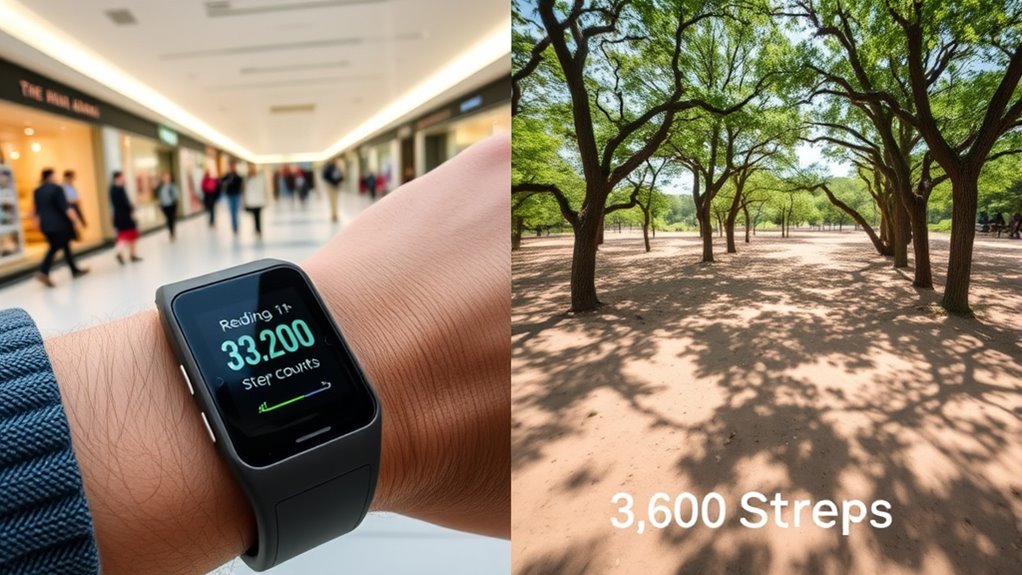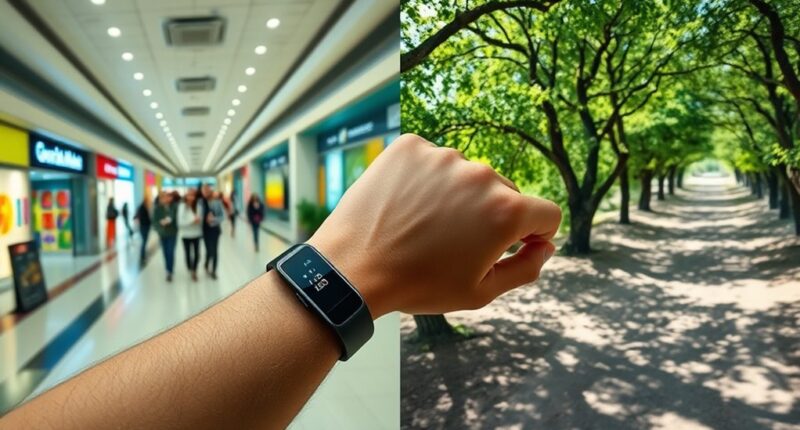Your fitness tracker counts steps differently at the mall versus the park because indoor settings and outdoor environments each affect how your device detects movement. Indoors, shorter, irregular steps, frequent stops, and different flooring can confuse sensors, leading to less accurate counts. Outdoors, longer strides and steady walking help the device track better. Environmental factors, walking patterns, and terrain all influence your step count, and understanding these differences can give you a clearer picture of your activity. Keep exploring to learn more.
Key Takeaways
- Indoor environments like malls often involve shorter, irregular steps that can confuse step-tracking algorithms.
- Walking surfaces and flooring types in malls versus parks affect sensor detection accuracy.
- Frequent stops and direction changes indoors impact step count consistency compared to steady outdoor walking.
- GPS signals are usually unavailable indoors, limiting cross-verification and influencing step measurement reliability.
- Device calibration and placement may perform differently depending on the walking environment, affecting step counts.

Fitness trackers have become popular tools for monitoring daily activity, but their step counts can vary markedly across brands and models. When you walk through a mall or take a stroll in the park, the device’s accuracy depends heavily on the environment and how you move. Indoor settings like malls often introduce unique challenges for trackers because your walking pattern differs from outdoor walks. Inside, you tend to take shorter, irregular steps, pause frequently, or change direction often. These movements can confuse a tracker’s algorithms, causing it to miscount steps. Additionally, the flooring—whether it’s smooth mall tiles or carpet—affects how well the accelerometer detects your motion. If the device relies solely on wrist movement, irregular gestures like browsing stores or stopping to chat can lead to overcounts or undercounts. Since GPS signals are limited indoors, the tracker can’t use distance data to cross-verify your steps, which further complicates accuracy. Indoor environments can significantly impact sensor performance, especially when walking patterns are inconsistent or movement is minimal. In contrast, walking outdoors in a park usually involves longer, more consistent strides with fewer stops. Your pace tends to be steady, and the natural ground provides a more uniform surface that helps the device sense your movements more reliably. This environment often results in more accurate readings because your walking pattern aligns better with what the device’s algorithms expect. However, even outdoors, factors like uneven terrain, walking speed, and device placement influence accuracy. For example, if you walk briskly or jog, some trackers tend to underestimate steps, whereas at slower speeds, they might overcount. Sensor technology advancements continue to improve accuracy, but environmental factors still play a critical role. Different devices and their underlying algorithms also play a role. Higher-end models like Garmin Forerunner 265 or COROS typically handle these variations better, thanks to sophisticated motion analysis and better sensor calibration. Cheaper or older devices may struggle, sometimes overcounting steps by significant margins, especially during irregular movements indoors. Firmware updates can improve accuracy over time, but they may also introduce inconsistencies in long-term comparisons. Ultimately, your tracker’s ability to count steps accurately depends on a combination of environmental factors, your walking style, and the device’s technology. Knowing this, you can interpret your step data more thoughtfully, recognizing that indoor and outdoor walks might not always be directly comparable.
Frequently Asked Questions
Do Different Brands of Fitness Trackers Count Steps Differently?
You might notice that different brands of fitness trackers count steps differently because they use varying algorithms and sensors. Some rely heavily on wrist movement detection, which can mistake other motions for steps, while others incorporate GPS or heart rate data for better accuracy. Factors like walking speed, terrain, and device placement also influence results, so your tracker’s brand and technology play a big role in how accurately it counts your steps.
How Does Arm Movement Affect Step Count Accuracy?
Arm movement can considerably impact your step count accuracy. When you swing your arms or make quick gestures unrelated to walking, your fitness tracker might interpret these motions as steps. This leads to overcounting, especially on wrist-based devices. To improve accuracy, consider adjusting sensitivity settings or wearing the device more snugly. Recognizing how arm movement influences readings helps you better understand and manage your tracker’s step count.
Can Wearing Position Impact Step Count Results?
They say “location is everything,” and that couldn’t be truer here. Wearing position definitely impacts your step count results. When you wear your tracker on your wrist, it might miss steps if you’re carrying something or cycling. Placing it on your hips or torso usually gives more accurate readings because these spots move more directly with your steps. So, where you wear it can make a noticeable difference in your data.
Do Environmental Factors Influence Tracker Accuracy?
Environmental factors definitely influence your tracker’s accuracy. When you walk indoors, interruptions and uneven surfaces can cause the device to miss steps or register false ones, especially if filters are active. Outdoors, steady terrain and consistent pace improve detection. External vibrations, electromagnetic interference, and your activity style—like holding shopping bags—also affect how well your device counts your steps, making environmental conditions a key factor in accuracy.
How Often Should I Calibrate My Fitness Tracker?
You might think your fitness tracker is perfect, but neglecting calibration can make it wildly inaccurate. For health sensors like blood pressure, re-adjust every 28 days; for distance and pace, walk outdoors for 20 minutes to update the accelerometer. Regular calibration ensures your data stays reliable, helping you hit your goals and stay healthy. Don’t let your tracker deceive you—keep it calibrated and accurate!
Conclusion
So, savvy step seekers, stay sharp and steer your stride smoothly. Remember, factors like surface, speed, and sensor sensitivity can substantially sway your step count. By understanding these subtle shifts, you can stay smarter about your steps, whether you’re mall-marching or park-perambulating. Keep calibrating, stay consistent, and celebrate your strides—because every step counts, no matter where you wander. Happy hiking, hopping, and hustling!








